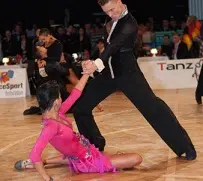The double step , whose correct mention is pasodoble as indicated by the Royal Spanish Academy ( RAE ) in its dictionary, refers to the march that, due to its rhythm, allows a troop to advance with an ordinary step . The dance performed with this rhythm is also called pasodoble.
 It should be noted that, at the military level, the ordinary step has a length of 65 centimeters and allows marching at a rate of 120 steps per minute. The double step, therefore, is a light march, accompanied by music with binary time.
It should be noted that, at the military level, the ordinary step has a length of 65 centimeters and allows marching at a rate of 120 steps per minute. The double step, therefore, is a light march, accompanied by music with binary time.
The double step, in short, was born as a military march . At the end of the 18th century , its music was already performed by military bands for parades .
As a dance , the double step emerged in Spanish territory. This is the name given to the dance that leads the dancers to move to the rhythm indicated above.
The paso doble is danced as a couple , with one member in front of the other and their bodies close together and a certain movement to the left. Dancers take one step at a time, keeping their bodies parallel and with one hand linked to their partner's.
It is important to know that when talking about Spanish pasodoble we are referring to three different elements:
-A dance.
-A musical genre that is usually performed by music bands of military origin, although over time it has become the type of music that music bands in any city perform during a bullfight.
-A genre of Spanish song that is closely linked to what is known as copla.
A very famous double step is “Suspiros de España” , whose composition was made by Antonio Álvarez Alonso in 1902 . Thirty-six years later, Juan Antonio Álvarez Cantos (nephew of the music composer) added lyrics and the song was performed by Estrellita Castro in a film of the same name ( “Suspiros de España” ).
Other of the most important pasodobles in history are the following:
-“Sing me a Spanish pasodoble.” This was premiered in 1954 at Madrid's Teatro Albéniz and was created by Tony Leblanc and Emilio Lehmberg. The first artist to sing it was Ana María Parra during the magazine play “You will see it and you will sing it.”
-“Long live the pasodoble”, which was popularized by the great singer Rocío Jurado. He included it in 1991 on his album titled “Sevilla”.
“La morena de mi copla”, composed by Carlos Castellano Gómez and Alfonso Jofre de Villegas Cernuda. Dating from 1939, it pays tribute to the great Córdoba painter Julio Romero de Torres and was performed for the first time by Estrellita Castro.
“The Entrance” is another well-known double step. Its composer was Quintín Esquembre and the work , dedicated to the Moors and Christians Festival of Villena , premiered in 1925 .
Many were and are singers who have specialized in singing pasodobles and who do it better than anyone else in this regard. And among those we can highlight, for example, Pablo Escobar from Almeria. This featured several well-known pasodobles, such as “Guapa”, “I can't love you” or “Que Viva España!”.
